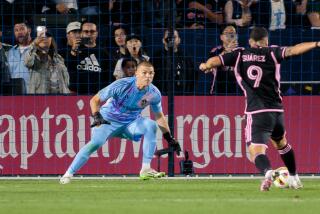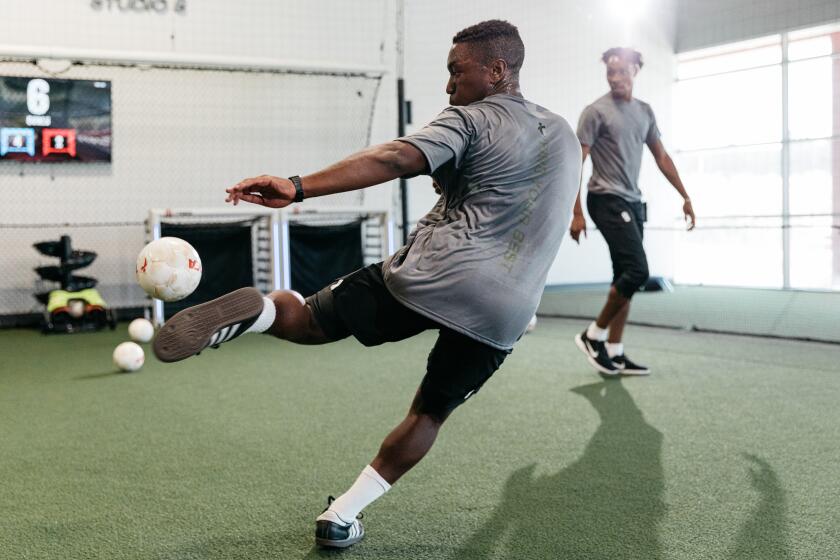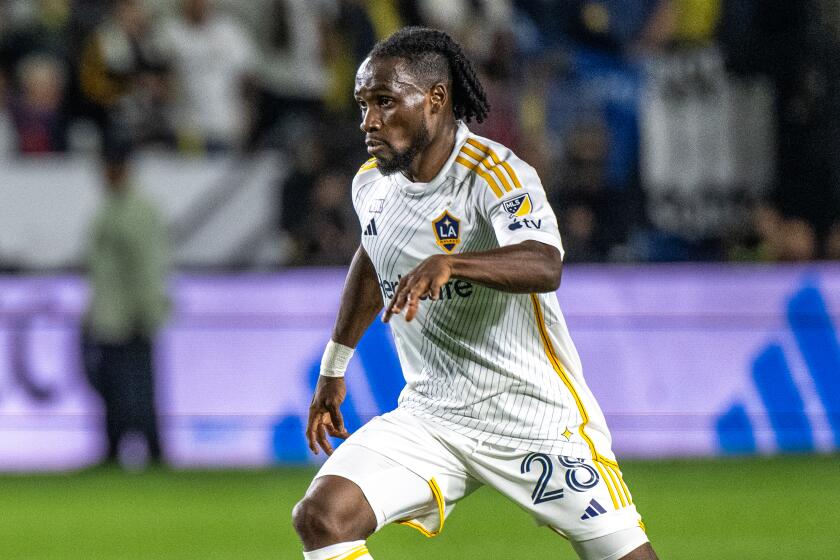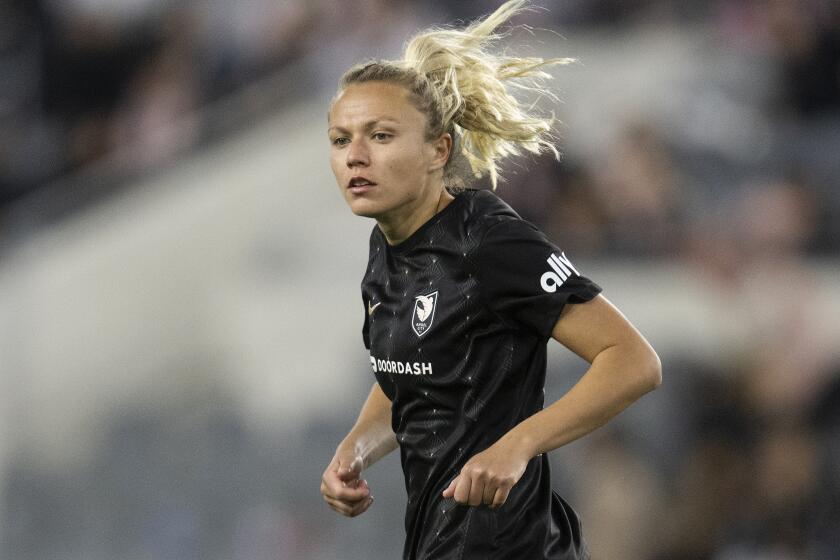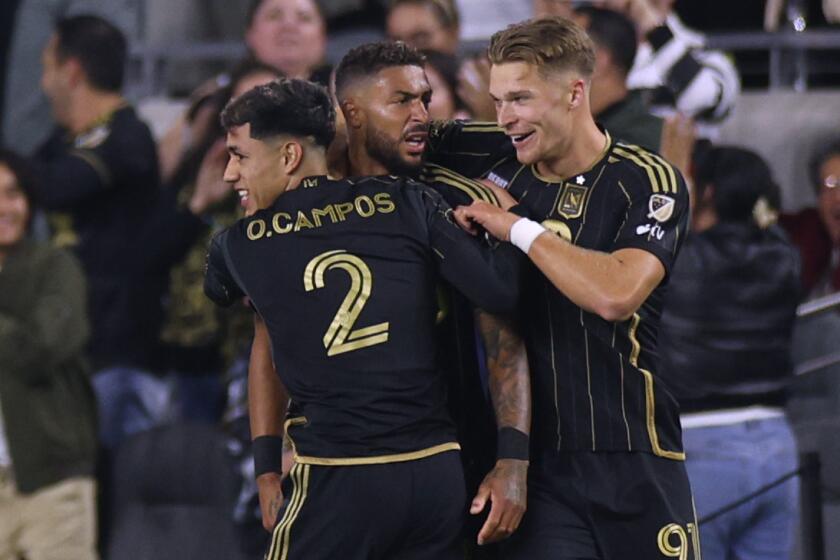Manchester United vs. City: Soccer rivalry where colors matter
MANCHESTER, England -- Mulligans, hidden on a dark one-way street in the center of England’s third-largest metropolis, is typical of many British pubs in that it serves warm beer, hot food and proudly discriminates based on color.
In a city fiercely divided between its two soccer teams, Mulligans is a Manchester United bar, all the way down to the large red-and-yellow logo pasted on the door to the bathroom stall. So when two visitors shuffle toward the entrance with the sky blue of rival Manchester City peeking out from beneath heavy winter coats, two beefy bouncers block their way.
“No colors, mate!” shouts the first.
“If you wear that in there,” warns the second “I can’t guarantee your safety.”
Think rivalries in the U.S. and you get Red Sox-Yankees, Lakers-Celtics or Auburn-Alabama. But those are little more than quaint disagreements compared with the blood feuds that separate fans — and define bars, restaurants and even taxis — in two-team English soccer cities like Manchester.
Manchester’s two clubs finished first and second in the English Premier League last year, when City won its first title in 44 years. And they’re running 1-2 again this winter, which has inflamed passions further.
“I hate United worse than my worst enemy. Worse than anything,” brags Kasim Zakaria, who shows his allegiance by hanging a now-odorless Manchester City air freshener from the rearview mirror of his cab.
Fortunately his three school-age children are just as rabid.
“If they weren’t,” he promises “I’d disown them.”
Like many parts of English history, the United-City rivalry dates to the Victorian Era, when a church rector replaced his parish’s cricket team with a soccer club, then challenged a nearby team formed two years earlier by a group of railway workers. And there was bad blood from the first match with the railway team, which would later become Man United, arriving at St. Mark’s calling themselves the Heathens.
The nonbelievers won, 3-0, establishing a template that would go largely unchallenged for more than a century, with United growing into the most successful club in English soccer history and arguably the most popular sports franchise of all time while City frequently found itself praying for divine intervention.
Those petitions were finally answered five years ago. With United in the middle of a streak that would see it win four English Premier League titles in five seasons, a group of deep-pocketed investors from Abu Dhabi bought the financially troubled Blues and immediately began remaking the City franchise, spending nearly a quarter of a billion dollars on transfer fees in their first year alone.
That investment paid off last year when United and City finished the season with identical records but City won the league championship — just its second since World War II — on a superior goal differential.
What had long been a rivalry fought mainly in the stands and the pubs had finally made its way back to the field. It’s a revival that Steve Uren, a 49-year-old City fan from a working-class district of West Manchester, has long waited for.
“The last four years have been brilliant. But the first 45 were tough,” Uren said as he shivered through a recent win over Stoke City.
A Blues fan “ever since I come out of me mum,” Uren refuses to address Manchester’s other team by name, referring to United simply as “them” while bragging about the numerous body parts he’s had tattooed with the City logo — body parts that, thankfully, both decorum and the New Year’s Day chill prevent him from showing off.
The thought that City would one day challenge United for soccer supremacy in Manchester was laughable for much of the last 60 years, during which the Reds won a record 17 EPL titles while City spent much of its time in the second and third division.
But United didn’t really begin developing into a worldwide brand until Sir Alex Ferguson’s appointment as manager in 1986. Under Ferguson, the team has won 24 major honors including 12 league titles, two UEFA Champions League crowns and a European Cup. In July, Forbes magazine valued United at $2.23 billion, making it the world’s richest sports franchise. And with nearly 300 million fans worldwide, according to a recent media research study, it’s the world’s most popular franchise as well.
Yet if United is steeped in history and success, City is full of promise — and money. Two years ago, The Times of London said, the club lost more than $315 million, the largest single-season deficit in international soccer history. It lost $160 million more en route to its title last year and at one point it was spending three times what it earned — largesse that allowed it to pay its players an average annual salary of nearly $7.8 million, nearly a third higher than United’s average.
That sea of red would have drowned any other EPL club, but it was nothing more than a rounding error in the City’s corporate suites since the team is effectively owned by what The Times calls the world’s largest sovereign wealth fund. With its Abu Dhabi portfolio valued at more than $1.6 trillion, the investment at City constitutes less than 1% of the fund’s overall worth.
UEFA’s Financial Fair Play regulations, designed to limit profligate spending when they go into effect next season, figures to curb the power of the purse — which is why City will start developing its own talent at the state-of-the-art youth academy it is building next to City of Manchester Stadium in a formerly depressed area of East Manchester.
As a result, the Manchester rivalry is likely to continue burning hot for years to come.
twitter.com/kbaxter11

